An Analysis of Cyber War and its Potential to Escalate to Physical War
VerifiedAdded on 2020/04/21
|9
|2425
|195
Essay
AI Summary
This essay delves into the multifaceted nature of cyber war and electronic warfare, examining their characteristics, and potential for escalation. It begins by defining cyber war as the use of computer technology to disrupt activities, contrasting it with physical warfare. The essay explores the dangers of both, highlighting that while cyber attacks may not cause immediate loss of life, they can have devastating long-term consequences, particularly if they target a nation's economy or critical infrastructure. The essay then discusses the different forms of cyber war, including governmental attacks and the use of malicious software, and explores the impact of cyber attacks, such as the WannaCry ransomware attack. The essay also considers the difficulty in attributing responsibility for cyber attacks and the potential for cyber war to cause financial crises or disrupt essential services. It concludes by discussing the conditions under which a cyber attack can be considered an armed attack, and the potential for cyber war to turn into physical war in the future, emphasizing the need for international cooperation and cyber security measures.
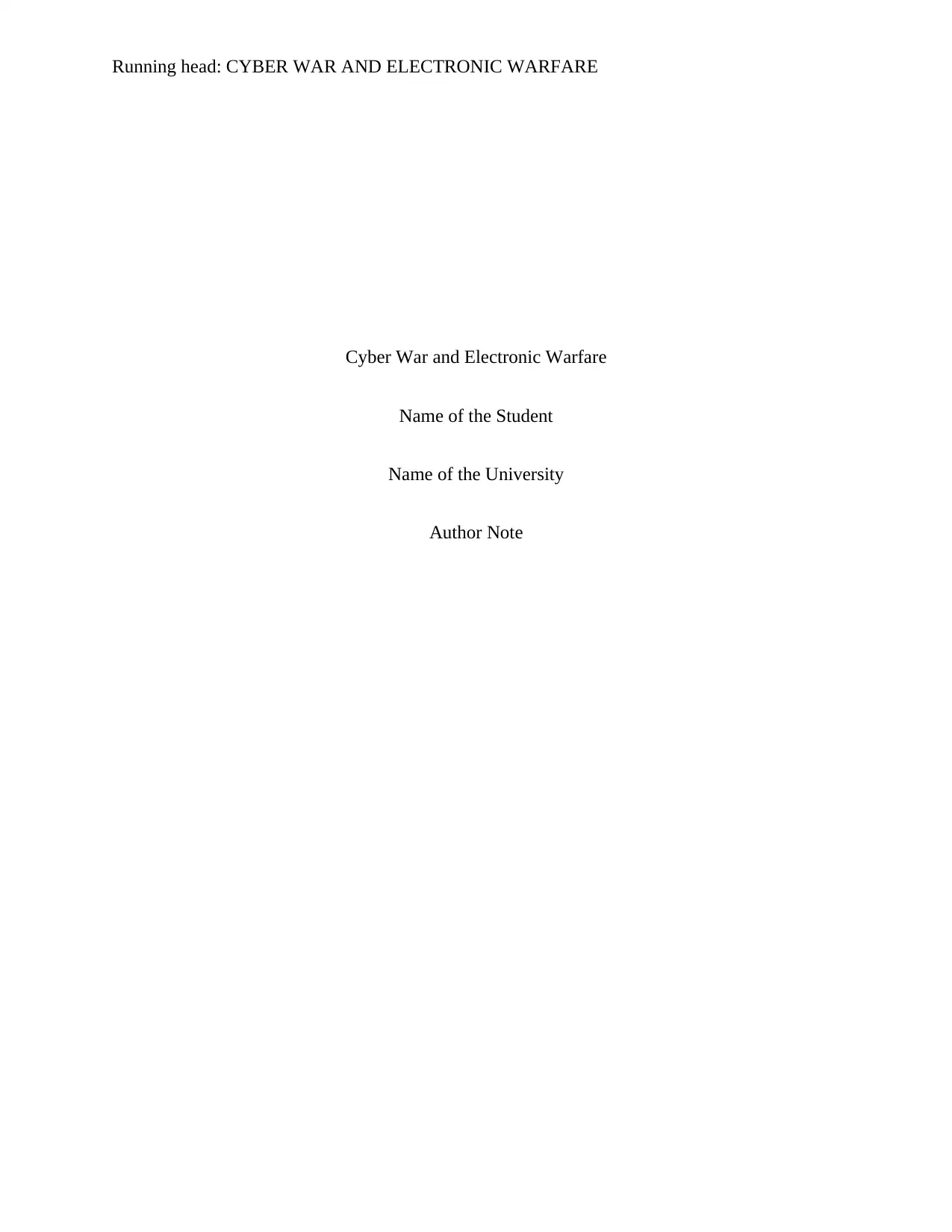
Running head: CYBER WAR AND ELECTRONIC WARFARE
Cyber War and Electronic Warfare
Name of the Student
Name of the University
Author Note
Cyber War and Electronic Warfare
Name of the Student
Name of the University
Author Note
Paraphrase This Document
Need a fresh take? Get an instant paraphrase of this document with our AI Paraphraser
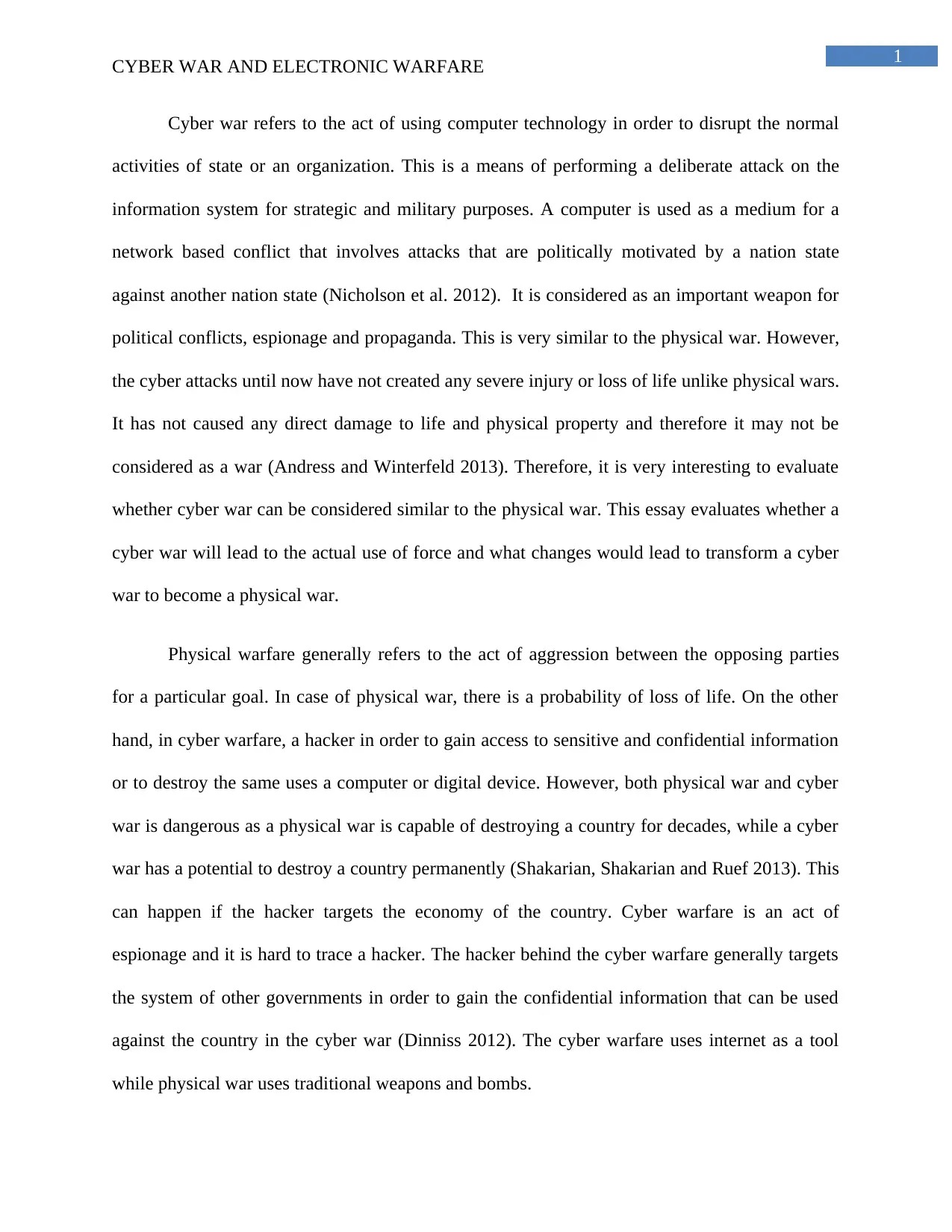
1
CYBER WAR AND ELECTRONIC WARFARE
Cyber war refers to the act of using computer technology in order to disrupt the normal
activities of state or an organization. This is a means of performing a deliberate attack on the
information system for strategic and military purposes. A computer is used as a medium for a
network based conflict that involves attacks that are politically motivated by a nation state
against another nation state (Nicholson et al. 2012). It is considered as an important weapon for
political conflicts, espionage and propaganda. This is very similar to the physical war. However,
the cyber attacks until now have not created any severe injury or loss of life unlike physical wars.
It has not caused any direct damage to life and physical property and therefore it may not be
considered as a war (Andress and Winterfeld 2013). Therefore, it is very interesting to evaluate
whether cyber war can be considered similar to the physical war. This essay evaluates whether a
cyber war will lead to the actual use of force and what changes would lead to transform a cyber
war to become a physical war.
Physical warfare generally refers to the act of aggression between the opposing parties
for a particular goal. In case of physical war, there is a probability of loss of life. On the other
hand, in cyber warfare, a hacker in order to gain access to sensitive and confidential information
or to destroy the same uses a computer or digital device. However, both physical war and cyber
war is dangerous as a physical war is capable of destroying a country for decades, while a cyber
war has a potential to destroy a country permanently (Shakarian, Shakarian and Ruef 2013). This
can happen if the hacker targets the economy of the country. Cyber warfare is an act of
espionage and it is hard to trace a hacker. The hacker behind the cyber warfare generally targets
the system of other governments in order to gain the confidential information that can be used
against the country in the cyber war (Dinniss 2012). The cyber warfare uses internet as a tool
while physical war uses traditional weapons and bombs.
CYBER WAR AND ELECTRONIC WARFARE
Cyber war refers to the act of using computer technology in order to disrupt the normal
activities of state or an organization. This is a means of performing a deliberate attack on the
information system for strategic and military purposes. A computer is used as a medium for a
network based conflict that involves attacks that are politically motivated by a nation state
against another nation state (Nicholson et al. 2012). It is considered as an important weapon for
political conflicts, espionage and propaganda. This is very similar to the physical war. However,
the cyber attacks until now have not created any severe injury or loss of life unlike physical wars.
It has not caused any direct damage to life and physical property and therefore it may not be
considered as a war (Andress and Winterfeld 2013). Therefore, it is very interesting to evaluate
whether cyber war can be considered similar to the physical war. This essay evaluates whether a
cyber war will lead to the actual use of force and what changes would lead to transform a cyber
war to become a physical war.
Physical warfare generally refers to the act of aggression between the opposing parties
for a particular goal. In case of physical war, there is a probability of loss of life. On the other
hand, in cyber warfare, a hacker in order to gain access to sensitive and confidential information
or to destroy the same uses a computer or digital device. However, both physical war and cyber
war is dangerous as a physical war is capable of destroying a country for decades, while a cyber
war has a potential to destroy a country permanently (Shakarian, Shakarian and Ruef 2013). This
can happen if the hacker targets the economy of the country. Cyber warfare is an act of
espionage and it is hard to trace a hacker. The hacker behind the cyber warfare generally targets
the system of other governments in order to gain the confidential information that can be used
against the country in the cyber war (Dinniss 2012). The cyber warfare uses internet as a tool
while physical war uses traditional weapons and bombs.
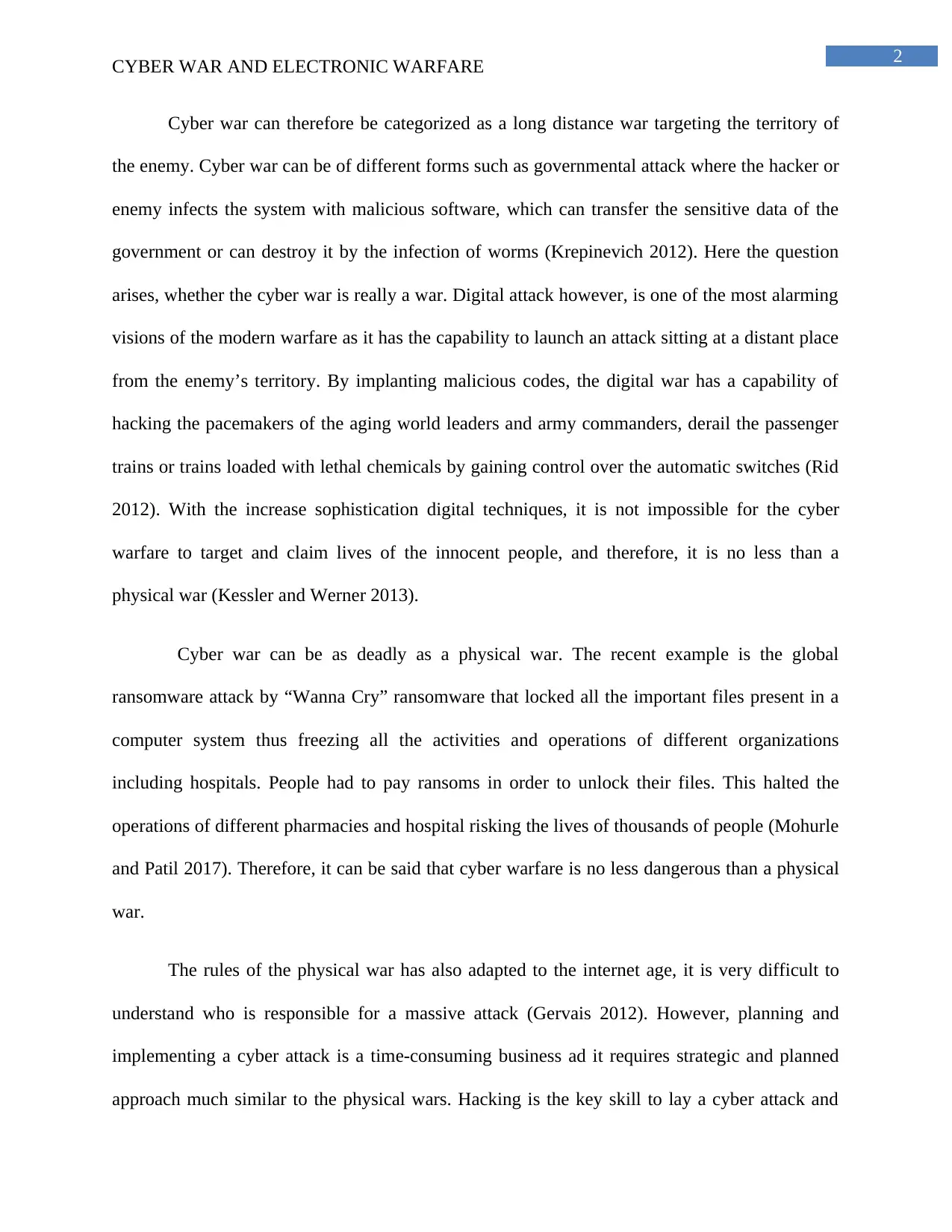
2
CYBER WAR AND ELECTRONIC WARFARE
Cyber war can therefore be categorized as a long distance war targeting the territory of
the enemy. Cyber war can be of different forms such as governmental attack where the hacker or
enemy infects the system with malicious software, which can transfer the sensitive data of the
government or can destroy it by the infection of worms (Krepinevich 2012). Here the question
arises, whether the cyber war is really a war. Digital attack however, is one of the most alarming
visions of the modern warfare as it has the capability to launch an attack sitting at a distant place
from the enemy’s territory. By implanting malicious codes, the digital war has a capability of
hacking the pacemakers of the aging world leaders and army commanders, derail the passenger
trains or trains loaded with lethal chemicals by gaining control over the automatic switches (Rid
2012). With the increase sophistication digital techniques, it is not impossible for the cyber
warfare to target and claim lives of the innocent people, and therefore, it is no less than a
physical war (Kessler and Werner 2013).
Cyber war can be as deadly as a physical war. The recent example is the global
ransomware attack by “Wanna Cry” ransomware that locked all the important files present in a
computer system thus freezing all the activities and operations of different organizations
including hospitals. People had to pay ransoms in order to unlock their files. This halted the
operations of different pharmacies and hospital risking the lives of thousands of people (Mohurle
and Patil 2017). Therefore, it can be said that cyber warfare is no less dangerous than a physical
war.
The rules of the physical war has also adapted to the internet age, it is very difficult to
understand who is responsible for a massive attack (Gervais 2012). However, planning and
implementing a cyber attack is a time-consuming business ad it requires strategic and planned
approach much similar to the physical wars. Hacking is the key skill to lay a cyber attack and
CYBER WAR AND ELECTRONIC WARFARE
Cyber war can therefore be categorized as a long distance war targeting the territory of
the enemy. Cyber war can be of different forms such as governmental attack where the hacker or
enemy infects the system with malicious software, which can transfer the sensitive data of the
government or can destroy it by the infection of worms (Krepinevich 2012). Here the question
arises, whether the cyber war is really a war. Digital attack however, is one of the most alarming
visions of the modern warfare as it has the capability to launch an attack sitting at a distant place
from the enemy’s territory. By implanting malicious codes, the digital war has a capability of
hacking the pacemakers of the aging world leaders and army commanders, derail the passenger
trains or trains loaded with lethal chemicals by gaining control over the automatic switches (Rid
2012). With the increase sophistication digital techniques, it is not impossible for the cyber
warfare to target and claim lives of the innocent people, and therefore, it is no less than a
physical war (Kessler and Werner 2013).
Cyber war can be as deadly as a physical war. The recent example is the global
ransomware attack by “Wanna Cry” ransomware that locked all the important files present in a
computer system thus freezing all the activities and operations of different organizations
including hospitals. People had to pay ransoms in order to unlock their files. This halted the
operations of different pharmacies and hospital risking the lives of thousands of people (Mohurle
and Patil 2017). Therefore, it can be said that cyber warfare is no less dangerous than a physical
war.
The rules of the physical war has also adapted to the internet age, it is very difficult to
understand who is responsible for a massive attack (Gervais 2012). However, planning and
implementing a cyber attack is a time-consuming business ad it requires strategic and planned
approach much similar to the physical wars. Hacking is the key skill to lay a cyber attack and
⊘ This is a preview!⊘
Do you want full access?
Subscribe today to unlock all pages.

Trusted by 1+ million students worldwide
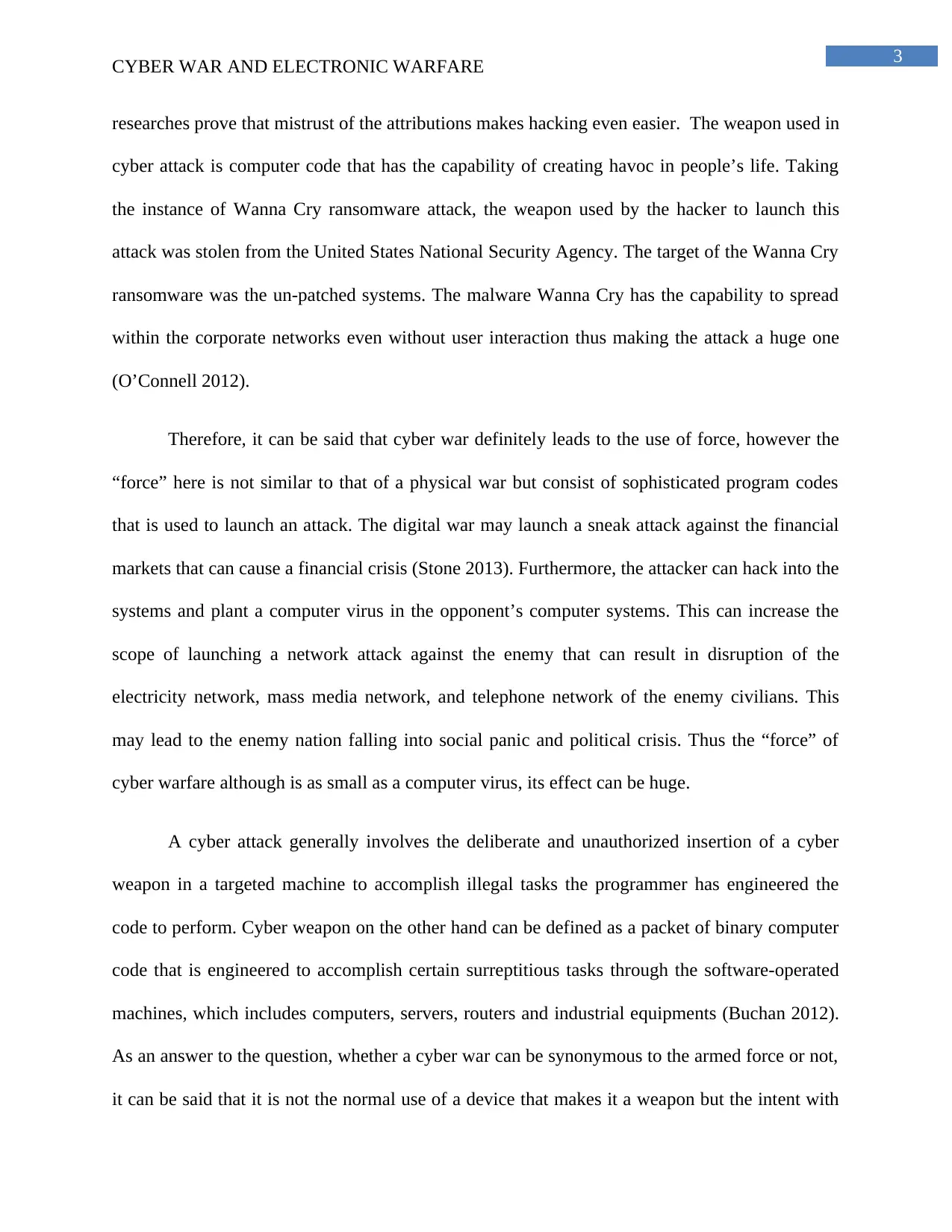
3
CYBER WAR AND ELECTRONIC WARFARE
researches prove that mistrust of the attributions makes hacking even easier. The weapon used in
cyber attack is computer code that has the capability of creating havoc in people’s life. Taking
the instance of Wanna Cry ransomware attack, the weapon used by the hacker to launch this
attack was stolen from the United States National Security Agency. The target of the Wanna Cry
ransomware was the un-patched systems. The malware Wanna Cry has the capability to spread
within the corporate networks even without user interaction thus making the attack a huge one
(O’Connell 2012).
Therefore, it can be said that cyber war definitely leads to the use of force, however the
“force” here is not similar to that of a physical war but consist of sophisticated program codes
that is used to launch an attack. The digital war may launch a sneak attack against the financial
markets that can cause a financial crisis (Stone 2013). Furthermore, the attacker can hack into the
systems and plant a computer virus in the opponent’s computer systems. This can increase the
scope of launching a network attack against the enemy that can result in disruption of the
electricity network, mass media network, and telephone network of the enemy civilians. This
may lead to the enemy nation falling into social panic and political crisis. Thus the “force” of
cyber warfare although is as small as a computer virus, its effect can be huge.
A cyber attack generally involves the deliberate and unauthorized insertion of a cyber
weapon in a targeted machine to accomplish illegal tasks the programmer has engineered the
code to perform. Cyber weapon on the other hand can be defined as a packet of binary computer
code that is engineered to accomplish certain surreptitious tasks through the software-operated
machines, which includes computers, servers, routers and industrial equipments (Buchan 2012).
As an answer to the question, whether a cyber war can be synonymous to the armed force or not,
it can be said that it is not the normal use of a device that makes it a weapon but the intent with
CYBER WAR AND ELECTRONIC WARFARE
researches prove that mistrust of the attributions makes hacking even easier. The weapon used in
cyber attack is computer code that has the capability of creating havoc in people’s life. Taking
the instance of Wanna Cry ransomware attack, the weapon used by the hacker to launch this
attack was stolen from the United States National Security Agency. The target of the Wanna Cry
ransomware was the un-patched systems. The malware Wanna Cry has the capability to spread
within the corporate networks even without user interaction thus making the attack a huge one
(O’Connell 2012).
Therefore, it can be said that cyber war definitely leads to the use of force, however the
“force” here is not similar to that of a physical war but consist of sophisticated program codes
that is used to launch an attack. The digital war may launch a sneak attack against the financial
markets that can cause a financial crisis (Stone 2013). Furthermore, the attacker can hack into the
systems and plant a computer virus in the opponent’s computer systems. This can increase the
scope of launching a network attack against the enemy that can result in disruption of the
electricity network, mass media network, and telephone network of the enemy civilians. This
may lead to the enemy nation falling into social panic and political crisis. Thus the “force” of
cyber warfare although is as small as a computer virus, its effect can be huge.
A cyber attack generally involves the deliberate and unauthorized insertion of a cyber
weapon in a targeted machine to accomplish illegal tasks the programmer has engineered the
code to perform. Cyber weapon on the other hand can be defined as a packet of binary computer
code that is engineered to accomplish certain surreptitious tasks through the software-operated
machines, which includes computers, servers, routers and industrial equipments (Buchan 2012).
As an answer to the question, whether a cyber war can be synonymous to the armed force or not,
it can be said that it is not the normal use of a device that makes it a weapon but the intent with
Paraphrase This Document
Need a fresh take? Get an instant paraphrase of this document with our AI Paraphraser
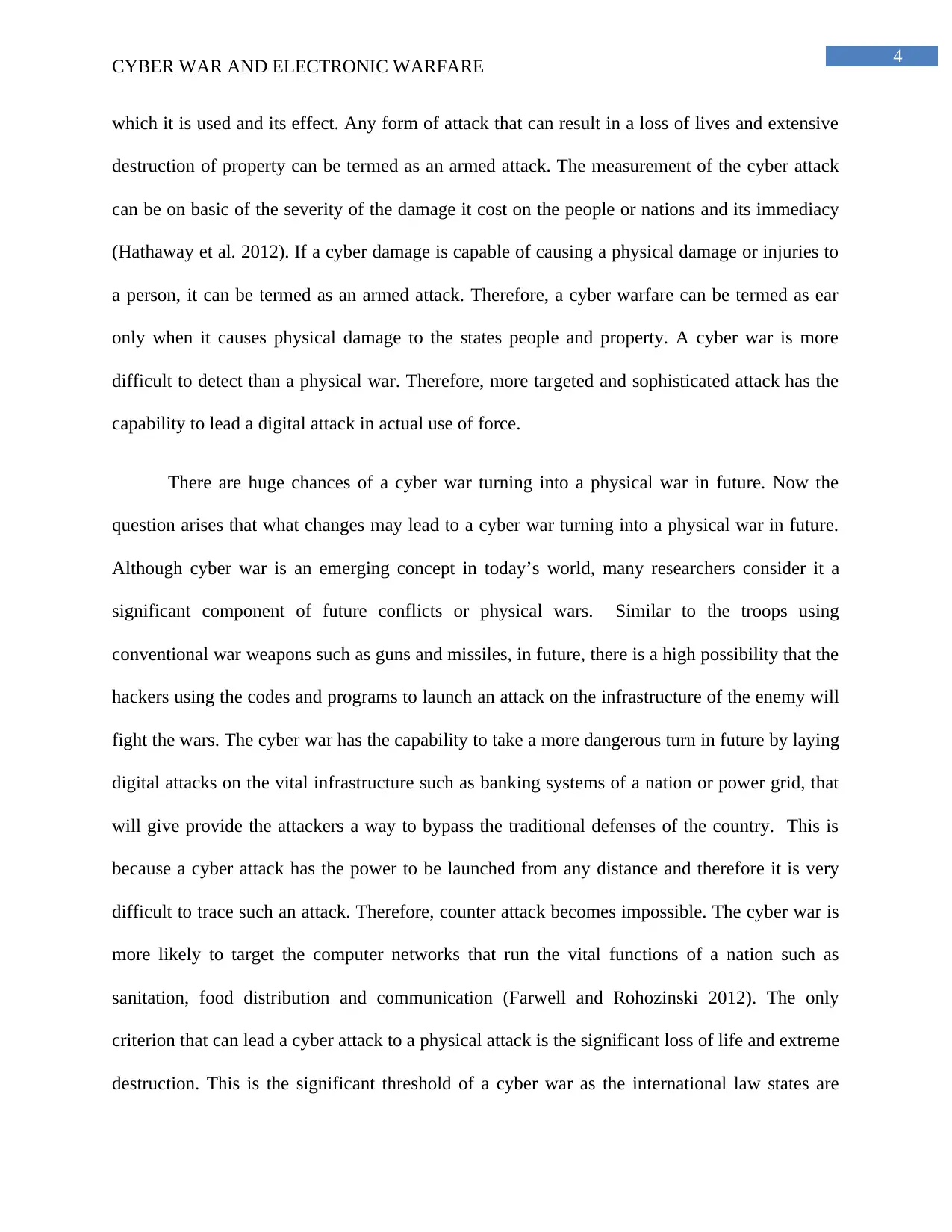
4
CYBER WAR AND ELECTRONIC WARFARE
which it is used and its effect. Any form of attack that can result in a loss of lives and extensive
destruction of property can be termed as an armed attack. The measurement of the cyber attack
can be on basic of the severity of the damage it cost on the people or nations and its immediacy
(Hathaway et al. 2012). If a cyber damage is capable of causing a physical damage or injuries to
a person, it can be termed as an armed attack. Therefore, a cyber warfare can be termed as ear
only when it causes physical damage to the states people and property. A cyber war is more
difficult to detect than a physical war. Therefore, more targeted and sophisticated attack has the
capability to lead a digital attack in actual use of force.
There are huge chances of a cyber war turning into a physical war in future. Now the
question arises that what changes may lead to a cyber war turning into a physical war in future.
Although cyber war is an emerging concept in today’s world, many researchers consider it a
significant component of future conflicts or physical wars. Similar to the troops using
conventional war weapons such as guns and missiles, in future, there is a high possibility that the
hackers using the codes and programs to launch an attack on the infrastructure of the enemy will
fight the wars. The cyber war has the capability to take a more dangerous turn in future by laying
digital attacks on the vital infrastructure such as banking systems of a nation or power grid, that
will give provide the attackers a way to bypass the traditional defenses of the country. This is
because a cyber attack has the power to be launched from any distance and therefore it is very
difficult to trace such an attack. Therefore, counter attack becomes impossible. The cyber war is
more likely to target the computer networks that run the vital functions of a nation such as
sanitation, food distribution and communication (Farwell and Rohozinski 2012). The only
criterion that can lead a cyber attack to a physical attack is the significant loss of life and extreme
destruction. This is the significant threshold of a cyber war as the international law states are
CYBER WAR AND ELECTRONIC WARFARE
which it is used and its effect. Any form of attack that can result in a loss of lives and extensive
destruction of property can be termed as an armed attack. The measurement of the cyber attack
can be on basic of the severity of the damage it cost on the people or nations and its immediacy
(Hathaway et al. 2012). If a cyber damage is capable of causing a physical damage or injuries to
a person, it can be termed as an armed attack. Therefore, a cyber warfare can be termed as ear
only when it causes physical damage to the states people and property. A cyber war is more
difficult to detect than a physical war. Therefore, more targeted and sophisticated attack has the
capability to lead a digital attack in actual use of force.
There are huge chances of a cyber war turning into a physical war in future. Now the
question arises that what changes may lead to a cyber war turning into a physical war in future.
Although cyber war is an emerging concept in today’s world, many researchers consider it a
significant component of future conflicts or physical wars. Similar to the troops using
conventional war weapons such as guns and missiles, in future, there is a high possibility that the
hackers using the codes and programs to launch an attack on the infrastructure of the enemy will
fight the wars. The cyber war has the capability to take a more dangerous turn in future by laying
digital attacks on the vital infrastructure such as banking systems of a nation or power grid, that
will give provide the attackers a way to bypass the traditional defenses of the country. This is
because a cyber attack has the power to be launched from any distance and therefore it is very
difficult to trace such an attack. Therefore, counter attack becomes impossible. The cyber war is
more likely to target the computer networks that run the vital functions of a nation such as
sanitation, food distribution and communication (Farwell and Rohozinski 2012). The only
criterion that can lead a cyber attack to a physical attack is the significant loss of life and extreme
destruction. This is the significant threshold of a cyber war as the international law states are
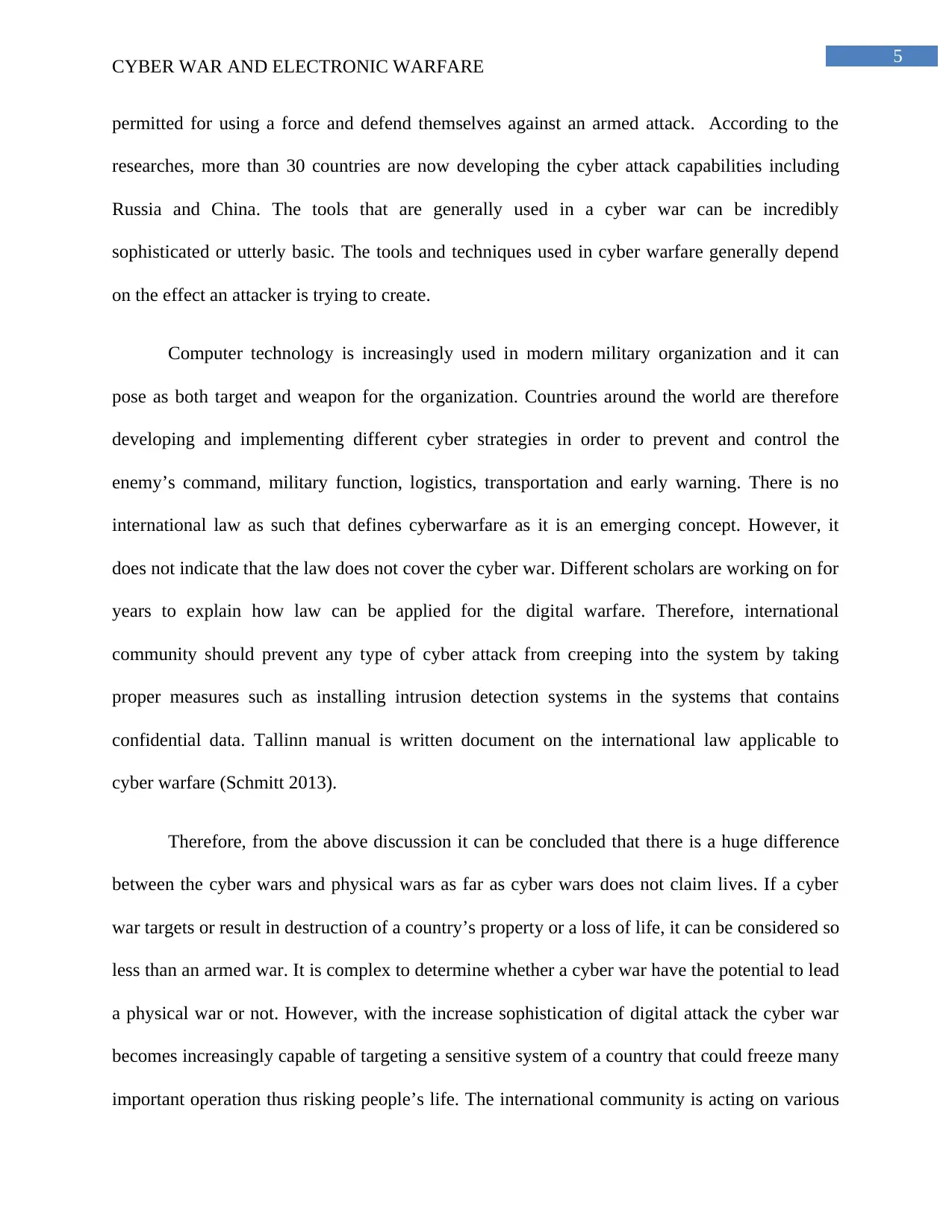
5
CYBER WAR AND ELECTRONIC WARFARE
permitted for using a force and defend themselves against an armed attack. According to the
researches, more than 30 countries are now developing the cyber attack capabilities including
Russia and China. The tools that are generally used in a cyber war can be incredibly
sophisticated or utterly basic. The tools and techniques used in cyber warfare generally depend
on the effect an attacker is trying to create.
Computer technology is increasingly used in modern military organization and it can
pose as both target and weapon for the organization. Countries around the world are therefore
developing and implementing different cyber strategies in order to prevent and control the
enemy’s command, military function, logistics, transportation and early warning. There is no
international law as such that defines cyberwarfare as it is an emerging concept. However, it
does not indicate that the law does not cover the cyber war. Different scholars are working on for
years to explain how law can be applied for the digital warfare. Therefore, international
community should prevent any type of cyber attack from creeping into the system by taking
proper measures such as installing intrusion detection systems in the systems that contains
confidential data. Tallinn manual is written document on the international law applicable to
cyber warfare (Schmitt 2013).
Therefore, from the above discussion it can be concluded that there is a huge difference
between the cyber wars and physical wars as far as cyber wars does not claim lives. If a cyber
war targets or result in destruction of a country’s property or a loss of life, it can be considered so
less than an armed war. It is complex to determine whether a cyber war have the potential to lead
a physical war or not. However, with the increase sophistication of digital attack the cyber war
becomes increasingly capable of targeting a sensitive system of a country that could freeze many
important operation thus risking people’s life. The international community is acting on various
CYBER WAR AND ELECTRONIC WARFARE
permitted for using a force and defend themselves against an armed attack. According to the
researches, more than 30 countries are now developing the cyber attack capabilities including
Russia and China. The tools that are generally used in a cyber war can be incredibly
sophisticated or utterly basic. The tools and techniques used in cyber warfare generally depend
on the effect an attacker is trying to create.
Computer technology is increasingly used in modern military organization and it can
pose as both target and weapon for the organization. Countries around the world are therefore
developing and implementing different cyber strategies in order to prevent and control the
enemy’s command, military function, logistics, transportation and early warning. There is no
international law as such that defines cyberwarfare as it is an emerging concept. However, it
does not indicate that the law does not cover the cyber war. Different scholars are working on for
years to explain how law can be applied for the digital warfare. Therefore, international
community should prevent any type of cyber attack from creeping into the system by taking
proper measures such as installing intrusion detection systems in the systems that contains
confidential data. Tallinn manual is written document on the international law applicable to
cyber warfare (Schmitt 2013).
Therefore, from the above discussion it can be concluded that there is a huge difference
between the cyber wars and physical wars as far as cyber wars does not claim lives. If a cyber
war targets or result in destruction of a country’s property or a loss of life, it can be considered so
less than an armed war. It is complex to determine whether a cyber war have the potential to lead
a physical war or not. However, with the increase sophistication of digital attack the cyber war
becomes increasingly capable of targeting a sensitive system of a country that could freeze many
important operation thus risking people’s life. The international community is acting on various
⊘ This is a preview!⊘
Do you want full access?
Subscribe today to unlock all pages.

Trusted by 1+ million students worldwide
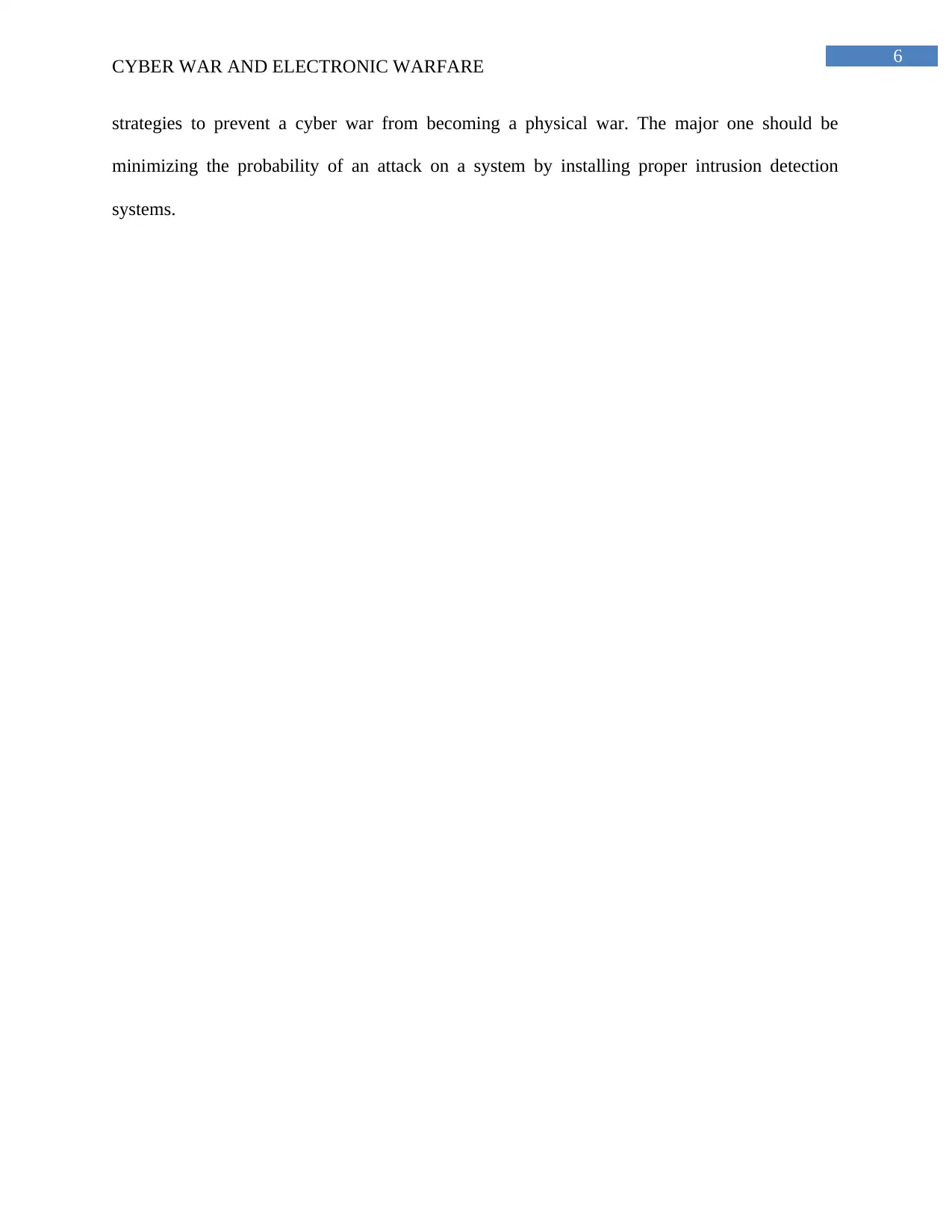
6
CYBER WAR AND ELECTRONIC WARFARE
strategies to prevent a cyber war from becoming a physical war. The major one should be
minimizing the probability of an attack on a system by installing proper intrusion detection
systems.
CYBER WAR AND ELECTRONIC WARFARE
strategies to prevent a cyber war from becoming a physical war. The major one should be
minimizing the probability of an attack on a system by installing proper intrusion detection
systems.
Paraphrase This Document
Need a fresh take? Get an instant paraphrase of this document with our AI Paraphraser
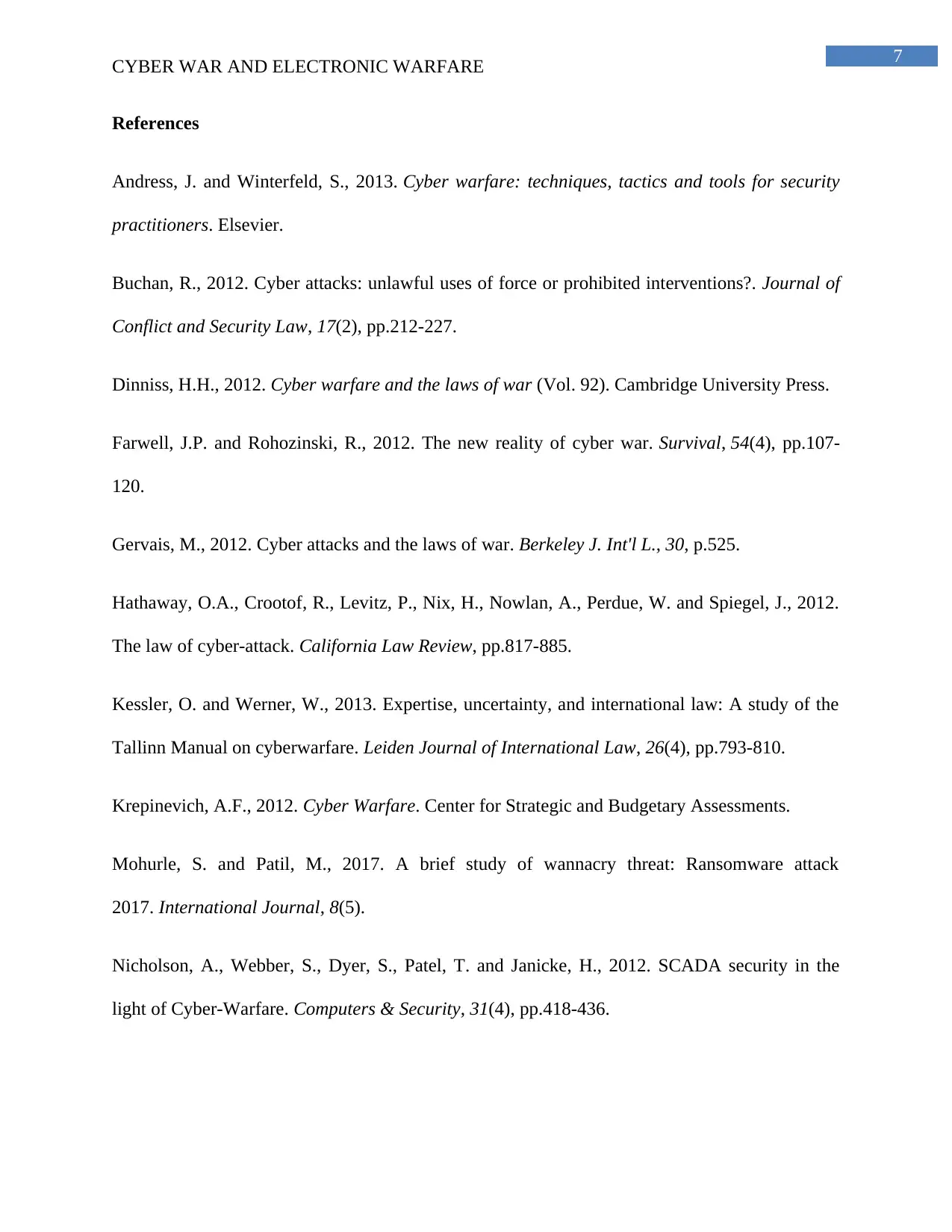
7
CYBER WAR AND ELECTRONIC WARFARE
References
Andress, J. and Winterfeld, S., 2013. Cyber warfare: techniques, tactics and tools for security
practitioners. Elsevier.
Buchan, R., 2012. Cyber attacks: unlawful uses of force or prohibited interventions?. Journal of
Conflict and Security Law, 17(2), pp.212-227.
Dinniss, H.H., 2012. Cyber warfare and the laws of war (Vol. 92). Cambridge University Press.
Farwell, J.P. and Rohozinski, R., 2012. The new reality of cyber war. Survival, 54(4), pp.107-
120.
Gervais, M., 2012. Cyber attacks and the laws of war. Berkeley J. Int'l L., 30, p.525.
Hathaway, O.A., Crootof, R., Levitz, P., Nix, H., Nowlan, A., Perdue, W. and Spiegel, J., 2012.
The law of cyber-attack. California Law Review, pp.817-885.
Kessler, O. and Werner, W., 2013. Expertise, uncertainty, and international law: A study of the
Tallinn Manual on cyberwarfare. Leiden Journal of International Law, 26(4), pp.793-810.
Krepinevich, A.F., 2012. Cyber Warfare. Center for Strategic and Budgetary Assessments.
Mohurle, S. and Patil, M., 2017. A brief study of wannacry threat: Ransomware attack
2017. International Journal, 8(5).
Nicholson, A., Webber, S., Dyer, S., Patel, T. and Janicke, H., 2012. SCADA security in the
light of Cyber-Warfare. Computers & Security, 31(4), pp.418-436.
CYBER WAR AND ELECTRONIC WARFARE
References
Andress, J. and Winterfeld, S., 2013. Cyber warfare: techniques, tactics and tools for security
practitioners. Elsevier.
Buchan, R., 2012. Cyber attacks: unlawful uses of force or prohibited interventions?. Journal of
Conflict and Security Law, 17(2), pp.212-227.
Dinniss, H.H., 2012. Cyber warfare and the laws of war (Vol. 92). Cambridge University Press.
Farwell, J.P. and Rohozinski, R., 2012. The new reality of cyber war. Survival, 54(4), pp.107-
120.
Gervais, M., 2012. Cyber attacks and the laws of war. Berkeley J. Int'l L., 30, p.525.
Hathaway, O.A., Crootof, R., Levitz, P., Nix, H., Nowlan, A., Perdue, W. and Spiegel, J., 2012.
The law of cyber-attack. California Law Review, pp.817-885.
Kessler, O. and Werner, W., 2013. Expertise, uncertainty, and international law: A study of the
Tallinn Manual on cyberwarfare. Leiden Journal of International Law, 26(4), pp.793-810.
Krepinevich, A.F., 2012. Cyber Warfare. Center for Strategic and Budgetary Assessments.
Mohurle, S. and Patil, M., 2017. A brief study of wannacry threat: Ransomware attack
2017. International Journal, 8(5).
Nicholson, A., Webber, S., Dyer, S., Patel, T. and Janicke, H., 2012. SCADA security in the
light of Cyber-Warfare. Computers & Security, 31(4), pp.418-436.
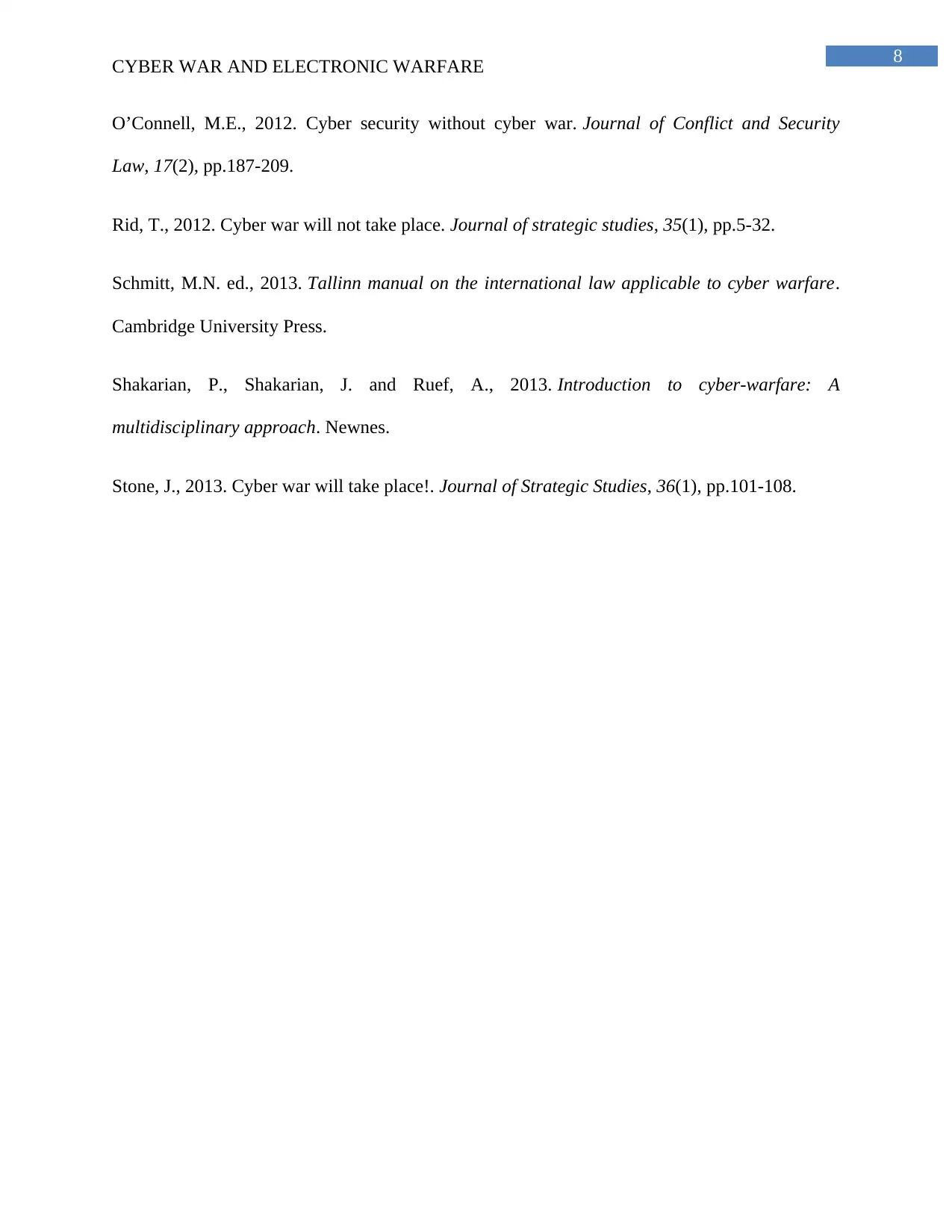
8
CYBER WAR AND ELECTRONIC WARFARE
O’Connell, M.E., 2012. Cyber security without cyber war. Journal of Conflict and Security
Law, 17(2), pp.187-209.
Rid, T., 2012. Cyber war will not take place. Journal of strategic studies, 35(1), pp.5-32.
Schmitt, M.N. ed., 2013. Tallinn manual on the international law applicable to cyber warfare.
Cambridge University Press.
Shakarian, P., Shakarian, J. and Ruef, A., 2013. Introduction to cyber-warfare: A
multidisciplinary approach. Newnes.
Stone, J., 2013. Cyber war will take place!. Journal of Strategic Studies, 36(1), pp.101-108.
CYBER WAR AND ELECTRONIC WARFARE
O’Connell, M.E., 2012. Cyber security without cyber war. Journal of Conflict and Security
Law, 17(2), pp.187-209.
Rid, T., 2012. Cyber war will not take place. Journal of strategic studies, 35(1), pp.5-32.
Schmitt, M.N. ed., 2013. Tallinn manual on the international law applicable to cyber warfare.
Cambridge University Press.
Shakarian, P., Shakarian, J. and Ruef, A., 2013. Introduction to cyber-warfare: A
multidisciplinary approach. Newnes.
Stone, J., 2013. Cyber war will take place!. Journal of Strategic Studies, 36(1), pp.101-108.
⊘ This is a preview!⊘
Do you want full access?
Subscribe today to unlock all pages.

Trusted by 1+ million students worldwide
1 out of 9
Related Documents
Your All-in-One AI-Powered Toolkit for Academic Success.
+13062052269
info@desklib.com
Available 24*7 on WhatsApp / Email
![[object Object]](/_next/static/media/star-bottom.7253800d.svg)
Unlock your academic potential
Copyright © 2020–2025 A2Z Services. All Rights Reserved. Developed and managed by ZUCOL.





